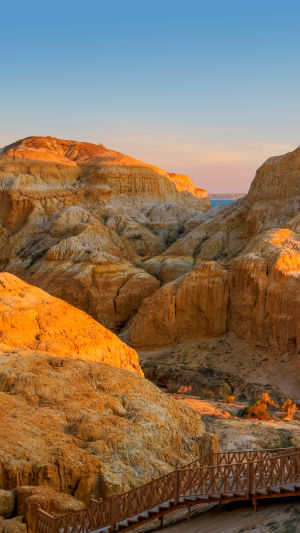Nature never ceases to amaze with its incredible artistry, and one such masterpiece is the Danxia landform. This geological wonder, characterized by its vibrant and intricate patterns of sedimentary rock, has captivated the imagination of travelers and scientists alike.
The Danxia landform, often referred to as "rainbow mountains," is a testament to the intricate dance between geological forces and the passage of time.
Formation of Danxia Landform
The formation of Danxia landforms is a result of a complex interplay between various geological processes spanning millions of years. It begins with the accumulation of different sediments such as sandstone, siltstone, and limestone over a prolonged period. As these sediments settle, layers of rocks form, each with distinct mineral compositions and colors. Over time, tectonic movements and uplifting forces act upon these sedimentary layers, causing them to buckle, fold, and fracture.
Subsequent erosion by wind, water, and ice gradually reveals the layers' true beauty.
What truly sets Danxia landforms apart is the breathtaking palette of colors that emerge from the exposed rock layers. Iron and other minerals in the sedimentary rocks create a vibrant spectrum of reds, oranges, yellows, and blues. These vivid hues are intensified by the interplay of sunlight, casting an almost otherworldly glow upon the landscape.
Best Places to Admire Danxia Landforms:
While Danxia landforms can be found in various parts of the world, the most iconic and well-preserved sites are located in China. Among the most renowned destinations to admire this natural wonder are Zhangye Danxia National Geological Park, Mount Danxia in Guangdong Province, and the UNESCO-listed Danxia Mountain in Jiangxi Province.
1. Zhangye Danxia National Geological Park: Nestled in the Gansu Province of China, Zhangye's otherworldly beauty has earned it the moniker "Rainbow Mountains." The park is a mesmerizing tapestry of reds, oranges, and yellows, seamlessly blending into one another. Visitors can explore the park on designated trails, offering panoramic vistas and the opportunity to witness the play of colors change with the shifting light.
2. Mount Danxia, Guangdong Province: This UNESCO World Heritage site boasts a diverse range of Danxia landforms. The unique formations here are characterized by their jagged peaks and towering pillars. The lush vegetation that clings to the vibrant rock surfaces creates a harmonious blend of color and life, making it a visual delight.
3. Danxia Mountain, Jiangxi Province: The Danxia landforms here present a more intricate and delicate appearance, with cascading layers resembling an artistic brushstroke. The UNESCO-listed site offers stunning viewpoints, serene temples, and a tranquil ambiance that allows visitors to immerse themselves in the enchanting landscape.
In all these locations, visitors can choose between hiking trails, observation platforms, and cable cars to appreciate the stunning vistas and intricate details of the Danxia landforms. The best times to admire these wonders are during sunrise and sunset when the interplay of light and shadow accentuates their vibrant colors and intricate textures.
In conclusion, the Danxia landform is a testament to the artistry of nature and the geological processes that have shaped our planet over millions of years.
Its breathtaking colors and intricate patterns have turned these landscapes into an unparalleled visual feast for travelers, photographers, and nature enthusiasts. China's Zhangye Danxia National Geological Park, Mount Danxia, and Danxia Mountain offer the most stunning examples of this phenomenon, allowing visitors to witness firsthand the awe-inspiring beauty of the rainbow mountains. These sites stand as a reminder of the Earth's boundless creativity and the magic that lies within its geological wonders.





